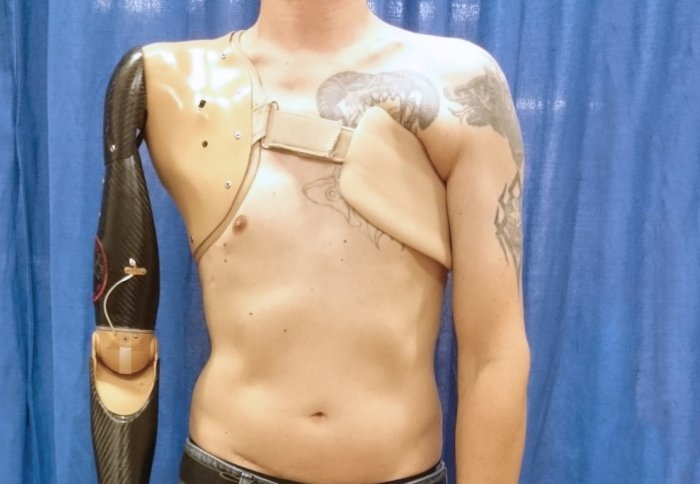Feb 7 2017
 The new robot prosthetic is controlled by be sensor, which sits firmly on the patients� pectoral muscle. Credit: Imperial College London
The new robot prosthetic is controlled by be sensor, which sits firmly on the patients� pectoral muscle. Credit: Imperial College London
Scientists at the Imperial College London have developed new sensor technology for a robotic prosthetic arm for detecting nerve signals in the spinal cord.
In order to control the prosthetic, the patients must imagine that they are controlling a phantom arm doing some simple movements, such as pinching two fingers together. The sensor technology interprets and uses the electrical signals sent from spinal motor neurons as commands.
A motor neuron is a nerve cell that is located in the spinal cord and with fibers, known as axons, that project outside the spinal cord to directly control muscles in the body.
The currently available robotic arm prosthetics are controlled by the patients twitching the remnant muscles in their arm or shoulder, which are often damaged. The technology used in these arm prosthetics is fairly basic in its functionality and is able to perform only one or two grasping commands. Globally, this limitation has led around 40 to 50% of users to discard these types of robotic prosthetics.
In the study, published in the Nature Biomedical Engineering journal, the scientists said that the signals sent by spinal motor neurons can be detected in parts of the body undamaged by amputation, rather than remnant muscle fiber, meaning that the sensors connected to the prosthetic can help detect more signals.
This means that the robotic prosthetic can ultimately be programmed with more commands to increase its functionality.
Dr Dario Farina, who is now based at Imperial College London, performed much of the research while he was at the University Medical Centre Gottingen. He conducted the research together with his co-authors in USA, Canada and Europe.
When an arm is amputated the nerve fibers and muscles are also severed, which means that it is very difficult to get meaningful signals from them to operate a prosthetic. We’ve tried a new approach, moving the focus from muscles to the nervous system. This means that our technology can detect and decode signals more clearly, opening up the possibility of robotic prosthetics that could be far more intuitive and useful for patients. It is a very exciting time to be in this field of research.
Dr Dario Farina, Department of Bioengineering, Imperial College London
The scientists performed experiments in the lab with six volunteers who were either amputees from the shoulder down or just above the elbow. Following some physiotherapy training, all six amputees were able to make a wide range of movements than would be possible with a classic muscle-controlled robotic prosthetic. The scientists came to this conclusion by comparing their research to earlier studies on muscle-controlled robotic prosthetics.
The volunteers were able to move their elbow joint and perform radial movements - moving the wrist from side to side - in addition to opening and closing the hand. This means that the patients have all basic hand and arm functions of a real arm.
Further refinements are required to make the technology more robust, however, the scientists suggest the current model could be available on the market in the next three years.
In the study, the volunteers underwent a surgical procedure at the Medical University of Vienna that included re-routing parts of their Peripheral Nervous System (PNS), connected with hand and arm movements, to healthy muscles in their body. This re-routing process, depending on the type of amputation, was either directed to the bicep in the arm or the pectoral muscle in the chest. This enabled the research team to clearly detect the electrical signals sent from the spinal motor neurons, a procedure the team relates to amplification of the signals.
In order to develop the technology, the scientists decoded and mapped some of the information in electrical signals released from the re-routed nerve cells and after that they interpreted them in computer models. Then, these models were compared with the models of healthy patients, which helped them to confirm the results.
Eventually, the researchers are planning to decode the meaning behind all signals sent from the spinal motor neurons, so that a complete range of arm and hand functions in the prosthetic can be programmed. This would help the patients use the prosthetic almost like their own arm.
The research team encoded particular motor neuron signals into the design of the prosthetic as commands, and then a sensor patch was connected on the muscle that had been functioning as part of the re-routing procedure, which was linked to the prosthetic. By working with physiotherapists, the amputees were able to learn how to control the device by thinking about particular phantom arm and hand commands.
The laboratory tests have taken the research team to the end of the proof of concept stage. As a next step, the researchers will involve extensive clinical trials with much broader cross section of volunteers in order to make the technology more robust.
The work was supported by the European Research Council, the Christian Doppler Research Foundation of the Austrian Federal Ministry of Science, Research and Economy and the European Union’s Horizon 2020 research and innovation program.